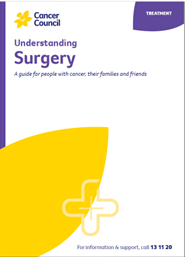Surgery to remove the cancer
Surgery to remove the tumour (resection) is the most common treatment for people with early-stage cancer who are in good health. It may also be considered for some stage 3 cancers, usually with chemotherapy (and sometimes radiation therapy) to shrink the tumour first. These stage 3 cancers are known as borderline resectable cancers, which means that surgery alone may or may not be able to remove all of the tumours.
Learn more about:
- Types of surgery
- How the surgery is done
- If the cancer has spread
- Having a Whipple procedure
- Video: Surgery for pancreatic cancer
Types of surgery
The aim of resection is to remove all the tumour from the pancreas, as well as a margin of healthy tissue. The type of surgery you have will depend on the size and location of the tumour, your general health and your preferences. Your surgeon will talk to you about the most appropriate surgery for you, as well as the risks and any possible complications. Types of surgery include:
Types of surgery include:
| Whipple procedure | This treats tumours in the head of the pancreas. Also known as pancreaticoduodenectomy, it is the most common surgery for pancreatic tumours. Learn more about this operation. |
| Distal pancreatectomy | The surgeon removes only the tail of the pancreas, or the tail and a portion of the body of the pancreas. The spleen is usually removed as well. The spleen helps the body fight infections, so if it is removed you are at higher risk of some types of bacterial infection. Your doctor may recommend vaccinations before and after a distal pancreatectomy. |
| Total pancreatectomy | When cancer is large or there are many tumours, the entire pancreas and spleen may be removed, along with the gall bladder, common bile duct, part of the stomach and small bowel, and nearby lymph nodes. |
How the surgery is done
Surgery for pancreatic cancer is carried out in hospital under a general anaesthetic. It is difficult surgery and should only be performed by surgeons with a lot of experience in doing this operation.
There are 3 main approaches:
| Open surgery | This involves one larger cut in the abdomen so the surgeon can remove the cancer. |
| Keyhole surgery | This involves several small cuts in the abdomen (belly). It is sometimes called laparoscopic or minimally invasive surgery. The surgeon inserts a long, thin instrument with a light and camera (laparoscope) into one of the cuts and uses images from the camera for guidance. The surgeon inserts tools into the other cuts to remove the cancer. |
| Robotic-assisted surgery | This is a type of keyhole surgery. The surgeon sits at a control panel to see a 3-dimensional image and moves robotic arms that hold the instruments. |
Open surgery is usually the best approach for pancreatic cancer, but keyhole or robotic-assisted surgery may be an option in some circumstances. Talk to your surgeon about what options are available to you. Ask about the risks and benefits of each approach, and check if there are any extra costs.
For more on this, see our general section on Surgery.
If the cancer has spread
During surgery to remove the cancer, the surgeon may find that the cancer has spread around one or more of the major blood vessels in the area or into the lining of the abdomen (peritoneum). This may occur even if you had several scans and tests beforehand.
If this happens, the surgeon will not be able to remove the cancer. However, they may be able to perform procedures (such as a bypass) to relieve some of the symptoms caused by the cancer.
For more on this, see our general section on Surgery.
→ READ MORE: Having a Whipple procedure
Video: Surgery for pancreatic cancer
Podcast: Making Treatment Decisions
Listen to more episodes from our podcast for people affected by cancer
Prof Lorraine Chantrill, Honorary Clinical Professor, University of Wollongong, and Head of Department, Medical Oncology, Illawarra Shoalhaven Local Health District, NSW; Karen Baker, Consumer; Michelle Denham, 13 11 20 Consultant, Cancer Council WA; Prof Anthony J Gill, Surgical Pathologist, Royal North Shore Hospital and The University of Sydney, NSW; A/Prof Koroush Haghighi, Liver, Pancreas and Upper Gastrointestinal Surgeon, Prince of Wales and St Vincent’s Hospitals, NSW; Dr Meredith Johnston, Radiation Oncologist, Liverpool and Campbelltown Hospitals, NSW; Dr Brett Knowles, Hepato-Pancreato-Biliary and General Surgeon, Royal Melbourne Hospital, Peter MacCallum Cancer Centre, and St Vincent’s Hospital, VIC; Rachael Mackie, Upper GI – Clinical Nurse Consultant, Peter MacCallum Cancer Centre, VIC; Prof Jennifer Philip, Chair of Palliative Care, University of Melbourne, and Palliative Medicine Physician, St Vincent’s Hospital, Peter MacCallum Cancer Centre and Royal Melbourne Hospital, VIC; Lucy Pollerd, Social Worker, Peter MacCallum Cancer Centre, VIC; Rose Rocca, Senior Clinical Dietitian – Upper GI, Peter MacCallum Cancer Centre, VIC; Stefanie Simnadis, Clinical Dietitian, St John of God Subiaco Hospital, WA.
View the Cancer Council NSW editorial policy.
View all publications or call 13 11 20 for free printed copies.
